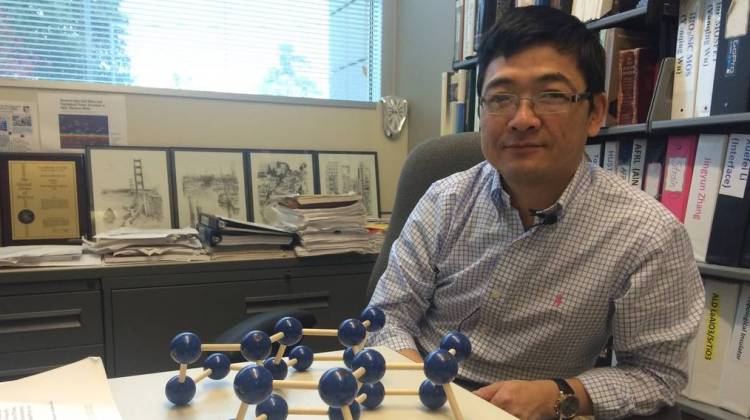
Peter Ye, an electrical engineering professor at Purdue University, with his model of black phosphorus
Sarah Fentem/IPBSResearch at Purdue has uncovered a naturally-occurring material that — in a phenomenon that seemingly defies logic — becomes thicker when it’s stretched.
Most materials get thinner vertically when they’re stretched horizontally. Think about how a water balloon becomes more fragile with more water inside. However, scientists have manufactured so-called “auxetic” materials that can do the opposite, thanks to a special way their atomic structures line up, like a hinge that opens.
But Purdue electrical engineering professor Peter Yeh says his team’s discovery marks the first time the phenomenon has been observed in nature. He compares it to complicated origami.
“But this is not from an artificial structure, but from the atomic structure itself, from mother nature,” he says. “Only this material has this structure.”
The material — black phosphorus — has atoms arranged in a certain lattice shape. Purdue electrical engineering professor Peter Ye says when black phosphorus is stretched, the element’s lattice opens up and creates more space between the atoms, making it thicker.
“The cross section expands instead of shrinking, because the atomic structure in this material is complicated,” Ye explains. “It has what we call a hatchet — or puckered — structure.”
Perhaps the most recognizable example of auxetic behavior is the Hoberman Sphere, the collapsible geodesic dome used as a toy in many elementary school classrooms.
An interdisciplinary team of electrical and mechanical engineers made the discovery about the element. Black phosphorus looks like the graphite in pencils and is emerging as a material of interest in the tech world because it can be sliced very thin and act as a semiconductor.
Ye says auxetics’ unique reaction could be good for making electronics that could withstand high temperatures.
“These mechanical properties are related to strain, for example,” he says. “So maybe electronic materials with these particular properties can be very stable.”
The scientists hope to see if the same thickening phenomenon occurs in super-thin materials, such as graphene, a layer of graphite sliced one atom thick.
 DONATE
DONATE










 Support WFYI. We can't do it without you.
Support WFYI. We can't do it without you.